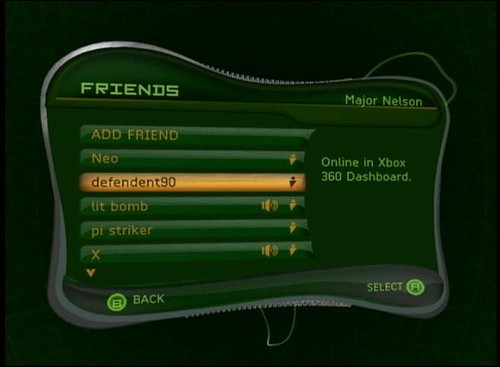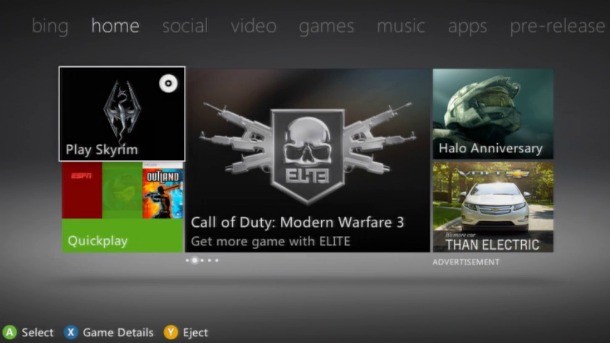Please support Game Informer. Print magazine subscriptions are less than $2 per issue
The Complete History Of Xbox Live (Abridged)

As the sun begins to set on the Xbox 360 and the second generation of Xbox Live, we thought it would be good to look back at the service to see how far it's come. Achievements, avatars, gamerscore, DLC, and Netflix are all part of the evolution, but where did it all begin?
In the beginning…

Before Microsoft raised eyebrows amongst gamers with the announcement of the original Xbox, people were happily gaming over phone lines with 56.6K modems. PC Gamers shrugged when the Dreamcast found success in connecting living rooms to the Internet. They had been playing with one another since before graphics were something people cared about.
However, the groundbreaking Phantasy Star Online showed platform holders that there was a market for online console gaming. Sony and Microsoft both took notice, but went down different paths to bring distant gamers together. While Sony opted for an external attachment (released alongside the first SOCOM title), Microsoft chose to include a broadband adapter inside each black-and-green console.
In 2000, when the Xbox was first announced, Microsoft came under fire for choosing to restrict online access to broadband. According to the Organisation for Economic Co-operation and Development, only 4.4 percent of households in the United States subscribed to a broadband service in 2000. By 2010, adoption had skyrocketed to 68.2 percent.
When we spoke with Microsoft in 2002, we were told that the purpose in choosing broadband was to push multiplayer as far as possible. They didn't want developers to have to dial back their ambitions to work on a dial-up connection.

Every Xbox owner would have the hardware in place to take advantage of Microsoft's broadband service without need of a peripheral, but they'd have to wait a little while. Xbox Live didn't launch until November 2002, which gave gamers an entire year to figure out how to play Halo: Combat Evolved over the Internet.
Thanks to two pieces of software, Xlink Kai and the GameSpy Tunnel, it was finally possible to ask the most important question in online gaming: "Why is that guy crouching and standing up over and over again?"
Voice chat wasn't possible in those early days before Xbox Live, and even when the service did become available, talking with strangers could sometimes be very odd thanks to the since-abandoned voice masking feature. Microsoft's former chief experience officer, J Allard, shared a story when we first covered the Xbox Live rollout.
"In 1999, we decided to do voice. We had eight hardcore gamers come [to Microsoft] to test out the prototype. I [said], 'You guys are going to be the first gamers to hear voice on a console game. Are you ready for it?’ They were like 'Hell, yeah! Bring it on!'
“They were all pumped up and everything, so we sent them off to eight different rooms. I sat in the lobby watching. I had my little headphones and they don't talk to each other. So, I bring them all out and said, 'What the hell is wrong with you guys? Is the system broken? Why aren't you talking to each other? Your lips aren't moving! I know it's not broken!'
“They responded with, 'We don't know each other.'
“I said that I knew that they spent all of their time in EverQuest and ICQ and are constantly messaging people they don't know, but they said, 'Well yeah. But I'm anonymous there. That's just letters on a screen with a *** name. Here, it's my real voice.' I never thought about that. With the exception of telemarketers, you really don't talk to strangers that you can't see or have some reason to meet.”
Before the service was rolled out to the world, I was part of a group of gamers that were selected as beta testers for Xbox Live. For our $50 entry fee, we received a memory card, Xbox Communicator puck, a headset, a slick carrying case, and a one-year subscription to the service (that started on the official launch date). NFL Fever 2003 and Revolt! were the two games included in the kit, and both worked extremely well for testing purposes.
Later on, as a token of appreciation, Microsoft sent beta testers a t-shirt that read "I've got great hands." Unfortunately, this begat an entire community site of "not safe for work" images featuring the apparel.
Allard was true to his word. Xbox Live launched in November 2002. Servers for the two launch titles, MechAssault and Unreal Championship, were flooded with eager fans. The service remained stable for the most part, which is a feat even by today's standards. At the time, Xbox Live was powered by five data centers located in London, Seattle, Tokyo, Redmond, and Tukwila.
More impressive than the system's integrity in those early days, I recall friendly banter and a general air of sportsmanship. The teabagging returned later.
The first Xbox DLC

We take for granted (and sometimes grimace) at the thought of downloadable content. Too often, publishers roll out new content immediately upon release, raising questions about what should and shouldn't be included on the disc.
There was a time when the very concept of additional maps, vehicles, and play modes in a console game seemed magical. I recall downloading my first add-on, a free pack of additional mechs for Day1 Studios' MechAssault. It wasn't long before Microsoft began charging for content.
The first paid DLC also belonged to MechAssault. For $4.99, players could expand the game with two new game types and three new maps (in addition to the mechs, maps, and modes available for free). After all the complementary content, kicking in a bit for some more felt like a fair deal. It wasn’t until later that users became more cautious about value for the DLC dollar as more publishers tested the waters with different types of add-ons.
Back in September 2002, J Allard told us, "We don't expect Activision to nickel and dime you for new levels and clothing." Today, most publishers charge for new multiplayer maps, and Microsoft has the market cornered on new clothing. We'll talk about Avatars later, though.
Next, the Xbox 360 is announced, bringing with it a host of changes for Xbox Live.

The Xbox 360 is announced
In May 2005, just four and a half years after the release of the Xbox, Microsoft stepped out on stage at a glitzy MTV Hollywood party to reveal the Xbox 360 the world. On this new system, Microsoft would double-down on its commitment to Xbox Live, making the online service an integral part of the system.
In addition to the subscription service (now named Xbox Live Gold), which is still required for online gaming, any user could create a free "Silver" account. This profile would be tied to Gamertags carrying over from the original Xbox, but enhanced with additional customization and matchmaking.
Players would now be able to set themselves up in "game zones" that were intended to identify the desired level of competition. Trash talkers, professionals, and friendly competitors all had a place to go. These groupings still exist, but their usefulness seems negligible.
Gamercards, customizable with a small thumbnail "gamerpic," showed off a user's Gamerscore tied to the new achievement system, game zone, review rating (one to five stars), and geographic location. The Xbox Guide, the gateway to the Xbox Dashboard, was only a button press away.
There, players could send messages to one another, rate recently encountered players, and purchase content from the Marketplace. Speaking of which…
The Evolution of Downloadable Content

In 2002, J Allard didn't expect publishers to come for our wallets. In 2005, he was leading the charge. Microsoft's experiment with downloadable content on the original Xbox was a success. With the creation of its new currency, Microsoft points, users were given fair warning to expect new, paid content for their favorite games. At E3 2005, Allard also introduced a fictional user named “Velocity Girl,” and promised that casual Xbox 360 owners like her would be able to get in on the action.
“She might never pick up a controller, never take a run in the half-pipe, but she’ll be able to design and sell stickers, shirts, boards, soundtracks, and even design her own skate parks for those hardcore gamers.” (Wow. This is definitely #1reasonwhy.)
Velocity Girl might still be waiting for her big Xbox Live Marketplace payday.
Unfortunately, paid DLC got off to a rough start when Bethesda released its first add-on for The Elder Scrolls IV: Oblivion. This "horse armor" was only cosmetic, and many players eager for their first bit of next-generation enhancements forked over the 200 Microsoft points ($2.50) only to realize that their purchase didn't get very much at all.
Since then, DLC has become a subject of debate due to varying quality of content. At its best, add-on material can expand the life of multiplayer communities and give players reason to revisit single-player campaigns. At its worst, it can leave gamers feeling abused and alienated. Paid add-ons that launch simultaneously with retail products have frustrated consumers for years, and there has been a shift in retailer pre-order bonuses from tangible items to in-game perks, missions, and cosmetic changes. Microtransactions for purely aesthetic reasons permeate the landscape and, if our crystal ball is accurate, this is a trend that will only grow as the Xbox 360 fades into history. There is great expansion content out there though, and many developers and publishers have pushed the boundaries of their game worlds thanks to the opportunities presented by DLC.
Next, the Xbox Dashboard gets a series of upgrades and visual overhauls.

The New Xbox Experience
Let's be honest. As much of an improvement as the original Xbox 360 dashboard's blades were over the Xbox's user interface, they weren't terribly attractive. Blades were certainly functional, but the space limitations imposed by a fixed number of pages inhibited growth.
Enter The New Xbox Experience (NXE).
In November 2008, just a few days after the Xbox 360's three-year anniversary, the dashboard received a complete overhaul. Gone were the static blades, replaced with a more dynamic display (though the original concept is available to this day by pressing the Guide button on the dashboard). The original five blades (System, Media, Games, Xbox Live, and Marketplace) were replaced by a vertically scrolling set of broad categories with mutable tiles. The Spotlight section allowed Microsoft to highlight new titles and promotions, with the game currently in the drive showcased on the far left.
By exploring the current title, users could install discs to the hard drive (a first with the NXE), view achievements, and browse related marketplace items like dashboard themes and in-game content. Scrolling to the Friends list highlighted one of the biggest features of the NXE: Avatars. Upon loading up the console for the first time after installing the update, users were instructed to pick and customize an avatar.
A variety of clothing options were available, with more added over the following weeks for free. Once Microsoft was sure people were hooked, new virtual apparel started carrying a price tag. Today, many games are teased with themed costumes and props. Popular fashion brands have also gotten in on the action, and when a 320 Microsoft point ($4) purchase price has become common, it's easy to see why. Thankfully, users can expand their collections with Avatar Awards earned by playing some games.
Once the Avatars were designed and dressed, parties with friends awaited. On the dashboard, it was easy to see which of your friends were in parties and with whom they were playing. The introduction of Netflix streaming also enabled viewing parties for a time. That feature, which saw surprising popularity, was killed off when the dashboard was updated to its current configuration. There were a lot of reasons to like the second iteration of the Xbox 360's Dashboard, and many still lament its abandonment by Microsoft.
USB Support and Kinect Arrive

In 2010, between The New Xbox Experience and the current “Metro” dashboard, Microsoft increased functionality of the Xbox 360 by enabling the use of USB drives for save data and profile transportation. Originally, storage was limited to 16GB, but has since been doubled.
Later that year, Microsoft began its foray into the world of motion control with an update that brought a flattened, cleaner visual look. In November 2010, it released a dashboard update that enabled voice and gesture interpretation for dashboard functions. The newly released Kinect sensor was put to good use early, but key features wouldn't be enabled until later.
Most notably, Netflix did not support the Kinect until April of 2011. Since then, many people have accidentally shouted at their television screens while watching on devices other than the Xbox 360.
The New, New Xbox Experience

In December 2011, Microsoft took the next big leap for the Xbox 360 Dashboard and Xbox Live experience. As part of an effort to unify the look of its products, the Xbox 360 user interface got a Windows Metro style overhaul first seen on the Windows Phone 7.
Gone were the vertically scrolling categories, as live tiles representing games, new social and media apps, and core functions took over. The Metro-style dashboard also heralded Microsoft's assault into the living room with a broader range of programming, including steaming sporting events and presidential debates, live television, and a simplified approach to finding media with system-wide search integration.
The latest dashboard has suffered criticism, especially in comparison to the NXE. Users have claimed it is harder to find content and that that advertising has become more instrusive.
The Future of Xbox Live

On Tuesday, we'll get our first look at how Xbox Live will function in the new Xbox environment. There are a number of questions we have, and we're hopeful that Microsoft will be forthcoming with the answers:
Will our Gamerscores carry over to the next generation?
Will our profiles remain largely anonymous to others or will we be using our real names and faces?
Will we see sharing functionality like Sony has incorporated into the PlayStation 4?
What is the future of second-screen experiences like SmartGlass? Will we be able to play in new ways remotely?
Will there be greater incorporation of tournament and league play at the system level (Microsoft could learn a lot from Activision's Call of Duty Elite)?
Tune in on Tuesday at 10 AM Pacific for as many of these answers as we can possibly get when we begin our coverage of Microsoft's Xbox reveal.










